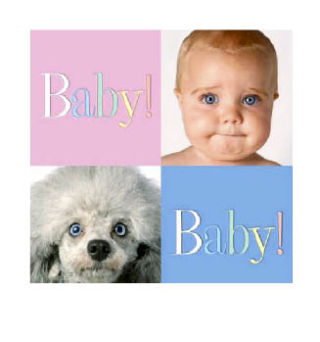As my friends start having children, I have developed the habit of hoarding board books. I always have four or five tucked away, and as soon as I get the good-news e-mail, I send a few books to the happy family. Some of my selections are books I have loved for years and have had the pleasure of watching children respond to, such as Eric Carle’s “Head to Toe,” Bruce Degen’s “Jamberry,” and Rod Campbell’s “Dear Zoo.” But I have also recently been charmed by a number of newer baby books.
My favorite board book of 2008 is “Baby! Baby!” by Vicky Ceelen. This wordless book consists of eleven pairs of photographs comparing infants and animals. The first spread shows a basset hound on the left, a baby on the right. Turning the page, we see a frog on the left, a baby on the right. Sounds pretty straightforward, right? What makes Ceelen’s work remarkable is the sometimes uncanny similarity between the subjects’ facial expressions, positions or attitudes. The basset hound and the baby both have their heads inclined toward the edges of the page, their respective paws and hands placed before them and their eyebrows raised as if in anticipation. The next baby lies on its stomach with its legs bent outward exactly like the legs of the frog on the facing page. Ceelen plays with perspective by always making the infant and the animal the same size, even when pairing child and caterpillar. The photographer’s approach, with babies in natural, practically candid poses, is a refreshing departure from a trend, in past decades, to photograph infants dressed as animals or plants. Gentle pastel colors frame each of the pictures in Ceelen’s tasteful, timeless book.
I’ve known a number of young children, including my goddaughters, Ada and Eve, who have loved looking at pictures of babies. Real babies. This year I came across two board books, both published by the Global Fund for Children, that I wish had been around when Ada and Eve were still in diapers. “To Be a Kid” leads readers on a round-the-world journey, with simple statements about childhood connecting one culture to another.
“To be a kid means eating a yummy snack and playing with your pet,” the text says, and the pictures show us examples of what those might mean in various countries. I like the way this book focuses on friends, fun and family; every child within it looks proud and happy — except perhaps the ones shown in school. How’s that for a universal truth!
“Global Babies,” similarly themed, is devoted solely to infants and toddlers. A single lovely sentence, the book’s entire text except for country names, affirms that every child, the world over, is special, but the true focus here is the photographs. Bright-eyed babies in traditional dress look out at us from every page, representing peoples from Fiji to Peru, from Greenland to Iraq. I have yet to come across another book that so successfully promotes peace with such a combination of beauty and brevity. Part of the proceeds from the sales of these two books go to the Global Fund for Children, a nonprofit organization serving children around the world. More information can be found at www.globalfundforchildren.org.
Since I first laid eyes on the colorful paper collage artwork of Betsy Snyder’s “Haiku Baby,” I haven’t been able to stop reading and re-reading it. Six tabs along the right edge of the book, designed to help baby fingers catch and flip pages, act as a kind of table of contents, showing pictures corresponding to the title of each short, seasonal poem, including rain, sun and leaf. On each page, Snyder offers children an early experience with the joys of language, focusing on single moments in the natural word. Japanese characters accompany the title of each poem. Though the formality of haiku might seem unnecessarily advanced for infants and toddlers, Snyder shows that it is the sounds which words make, in combination with the visual experience a book provides, that really matter.
A number of new board books appeared this year from authors who have already proven themselves with our youngest audiences. Matthew Van Fleet, who wowed the lift-the-flap, touch-and-feel world with “Tails and Dog,” now gives us “Alphabet,” with moveable parts, flaps and textured patches on every page. Amy Wilson Sanger’s “Chaat and Sweets” is a great addition to the World Snacks series, offering rhythm and rhyme, and making your mouth water for Indian food. Leslie Patricelli adds “No No Yes Yes” and “Baby Happy Baby Sad” to her popular books featuring a rosy-cheeked, wide-mouthed baby sporting nothing but its diapers. A pleasant surprise for me is Michelle Sinclair Colman’s and Nathalie Dion’s “Eco Babies Wear Green.” Every book in this duo’s “Babies Wear” series attempts to pair adult concepts with toddler antics, but this is the first one, I feel, to deliver the humor while staying true to the nature of the young child. “Eating local” is a grown-up idea, but the baby we see in the picture for the page saying “Eco babies eat local,” sits between rows in a u-pick field smashing strawberries into her face — as a child truly would.
Of course, there are many, many more board books to recommend. Need more ideas? Let me just go check my stash …
Galen Longstreth is an MFA student at Vermont College. She received a master’s in Early Childhood and Elementary Education from the University of Pennsylvania, where she taught kindergarten for five years. She is a 1994 graduate of Mercer Island High School. She can be reached at glongstr@gmail.com.




